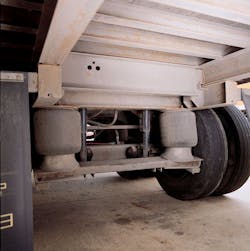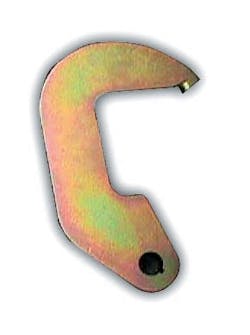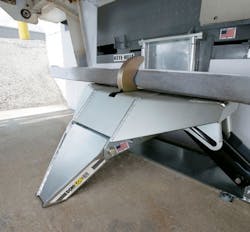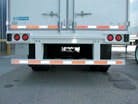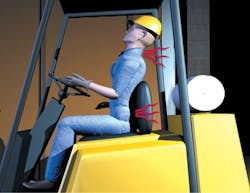Trailer restraints do much more than restrain trailers
Vehicle restraints were invented to help stop forklifts from tumbling from a loading dock and crippling or killing drivers. For nearly three decades, they’ve done that job well.
But they do more. They make loading docks more productive and support efficient supply chains. Modern restraints also reduce the risk of neck and back injuries to forklift drivers by reducing trailer drop – vertical trailer bed movement caused by the weight of forklifts traveling in and out of trailers - that can jolt forklift operators.
Restraints play a strategic role as part of ergonomic dock designs that protect employee health and wellness. In their original function, restraints secure trucks of any size, shape, height and configuration to the loading dock, while helping to prevent trailer-separation accidents (Figure 1).
Figure 1. A trailer that isn’t properly stabilized moves substantially in both the vertical and horizontal directions, causing problems such as damaged equipment and products, chronic back injuries to forklift operators, serious accidental injuries, and greatly decreased productivity.
Given these advantages, the selection of vehicle restraints is a business decision that deserves attention from multiple functions: warehousing and logistics managers, safety directors, operations management and executives. A restraining system that fits the work environment contributes to a safe workplace, a competitive supply chain and strong business performance.
Simple beginnings
Vehicle restraints are needed because wheel chocks alone proved ineffective for holding trailers at the dock during loading. Repeated jolts from forklifts can cause trailers to creep away from the dock until a gap opens at the dock edge (Figure 2).
Figure 2. With the advent of air-ride suspension trailers in the early 1990s, bed heights could fluctuate by several inches as left trucks added or removed loads. Such trailers could bounce and progressively “walk” away from the dock, a serious problem for forklift operators.
The forklift and driver then can fall to the pavement, with catastrophic results.
Aside from being unreliable and prone to slipping on snow or ice, wheel chocks provided no signal to let forklift operators know if they could safely load, or to tell truckers when they could safely depart. As a result, truckers sometimes pulled trailers away while a forklift was entering, again causing serious incidents.
The first vehicle restraints addressed the problem effectively. When a trailer is backed up to a dock, a hook inside a wall-mounted housing rotated up to grab the rear impact guard (RIG), holding the truck in place (Figure 3). If the trailer was secure, forklift drivers saw a flashing green light. When the RIG was released, they saw a flashing red light. Truckers, meanwhile, saw a red light when the trailer restraint was engaged.
Figure 3. Introduced in the late 1990s, the “fish hook” is designed to wrap around the rig to protect against every known form of trailer separation.
When it disengaged, they saw a green light, which told them they were cleared to leave(Figure 4).
Figure 4. Automated vehicle restraints like this reduce the potential for accidents at the loading dock. By supporting the rear of the trailer during loading and unloading, vertical and horizontal trailer movement is minimized.
This configuration, built on a national survey of thousands of trailers and five years of development, worked on 95% of trucks. In 1981, OSHA recognized the restraints as an acceptable alternative to wheel chocks. Companies of every size and across industries adopted the technology, which became fundamental to dock designs.
Changing landscape
Then, life at the loading dock began to change. Through the 1980s, companies pushed for more efficient supply chains and preferred trucks that could carry bigger payloads.
Trailers were switched to low-profile tires and rims to increase box size without increasing clearance height. Air suspensions cushion the ride, protect cargo and extend trailer life.
These new trailers – longer, wider and taller, with lower beds – challenged lift truck drivers. At the same time, plants demanded more productivity on the dock. Faster servicing of new trailers carrying wider, taller loads added to safety concerns.
Vehicle restraints had to adapt, holding on to RIGs at the typical 30 in. above the road, yet reaching down to secure low-bed trailers with RIGs as low as 12 in. above the ground. Modifications such as a low-profile nose extension on the restraint housing provided the necessary working range.
Adding complexity, some trucks had hydraulic rear liftgates for use at facilities that had no dock levelers. These units had no RIGs for traditional restraints to grab. The response was wheel-locking restraints. As the trailer backs in, an automatic barrier rod is positioned against and ahead of a rear tire. These restraints can secure virtually every trailer.
Gaining prominence
When supply chain efficiency became universally recognized as a key to competitive advantage, business saw a safe, productive loading dock as a key link in the distribution chain.
Yet new hazards emerged at the loading dock. Trailers with air-ride suspensions have a bed height that can fluctuate by several inches as lift trucks add or remove loads (Figure 5). These trailers have a natural tendency to bounce with the weight of loads and progressively move away from the dock. The bouncing can cause some restraint designs to lose their grip on the RIG.
Figure 5. Through the 1990s, vehicle restraints had to adapt to secure low-bed trailers with RIGs as low as 12 in. above ground.
Trailers spotted at the dock and supported by landing gear are another source of danger. Lift truck traffic can rock the trailer until the landing gear collapses, causing the trailer to pitch forward or fall to the side. The weight of a lift truck at the trailer’s front end can force the nose down and the back end up and away from the building. If the tandem wheels are in a forward position, a lift truck entering can cause the rear of the trailer to scoot forward and drop. This, in turn, causes the trailer nose to pop up.
It’s clear that vehicle restraints must do more than resist trailer movement straight out and away from the building. In effect, they have to trap the RIG so that it can’t move outward, rise or tip. The resulting technological advance is improved rotating hook designs, ensuring that the hook wraps around the RIG, providing two-point entrapment that protects against every form of trailer separation.
Addressing ergonomics
Industry now looks beyond catastrophic dock accidents and focuses on addressing long-term wellness issues, including the risk of chronic spinal injuries to lift truck drivers.
Analysis of the trailer loading and unloading process showed that trailer beds drop every time a lift truck travels in and out. Trailer drop is especially severe in trailers with air-ride suspensions. Trailer drop means forklift drivers get a jolt to the neck and spine every time they enter a trailer, which they might do hundreds of times in a shift.
The risk of injury can be significant, and so are the potential costs. Studies by the National Institute for Occupational Safety and Health (NIOSH) report that 36% of the head, neck and back injuries mobile equipment operators suffer are caused by shock (jarring and jolting).
One-fourth of workplace illnesses and injuries in the United Sates are back related, according to the National Safety Council. The American Society of Orthopedic Surgeons states that back injuries are the nation’s most costly medical condition. Back injuries are estimated to cost U.S. companies billions of dollars every year.
A first-time back injury can cost as much as $10,000 in doctor visits, medication and physical therapy. A recent study published by Ohio State University shows that the more severe back injuries, which can occur when a person is repeatedly hurt, can cost as much as $300,000.
Modern trailer restraints have addressed the issue since 2005. These devices stabilize the trailer and help prevent both vertical and horizontal movement (Figure 6).
Figure 6. Back injuries, such as those suffered by lift truck drivers crossing between docks and trailers hundreds of times per day, are the most costly medical condition in the country, according to the American Society of Orthopedic Surgeons.
Specifically, the restraint provides vertical support to the trailer with hydraulic cylinders that resist downward movement as lift trucks enter. Additionally, the design uses a rotating hook to prevent trailer separation.
This restraint design reduces the average trailer deflection to a maximum of two inches, versus an average of six in. without the vertical support. That stability equates to reduced stress on lift truck drivers and lower risk of back and neck injuries.
And a stable trailer reduces product and equipment damage resulting from trailer drop. Since its introduction, these advanced restraints have found acceptance in a range of industries because of its ability to provide a smooth transition between the dock floor and trailer.
Exceeding expectations
Vehicle restraints have made major contributions to material handling safety. Their versatility and benefits have gone far beyond what the inventors envisioned nearly three decades ago. In preventing serious workplace accidents, in adapting to sweeping changes in the loading dock environment, and in reducing occupational injuries and disabilities with their attendant costs, vehicle restraints have become more essential than ever for companies seeking a safe route to strong business performance.
Joe Manone is vice president of Rite-Hite Corp., Milwaukee. Contact him at (800) 456-0600.


